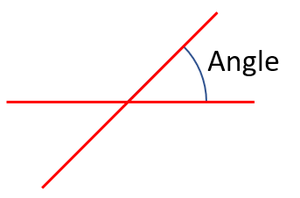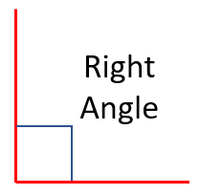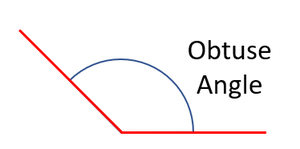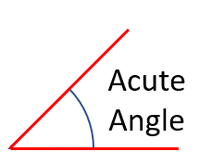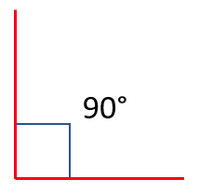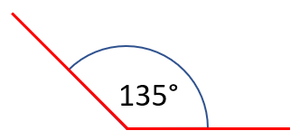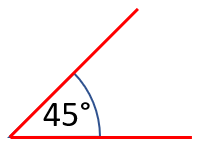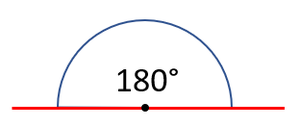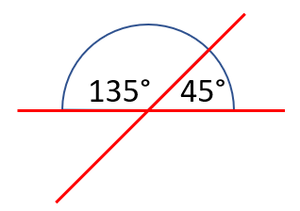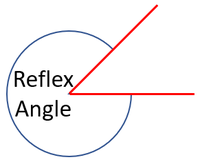Difference between revisions of "Angle"
| Line 38: | Line 38: | ||
: [[Angle]]s are measured in [[degree]]s (°). | : [[Angle]]s are measured in [[degree]]s (°). | ||
: A [[protractor]] can be used to [[measure]] the [[angle]] between to lines. | : A [[protractor]] can be used to [[measure]] the [[angle]] between to lines. | ||
| − | : There are 360 [[degree]]s (360°) | + | : There are 360 [[degree]]s (360°) around a point. |
{| class="wikitable" | {| class="wikitable" | ||
|- | |- | ||
| Line 91: | Line 91: | ||
: [[Angle]]s are measured in [[degree]]s (°). | : [[Angle]]s are measured in [[degree]]s (°). | ||
: A [[protractor]] can be used to [[measure]] the [[angle]] between two intersecting lines. | : A [[protractor]] can be used to [[measure]] the [[angle]] between two intersecting lines. | ||
| − | : There are 360 [[degree]]s (360°) | + | : There are 360 [[degree]]s (360°) around a point. |
{| class="wikitable" | {| class="wikitable" | ||
|- | |- | ||
| Line 145: | Line 145: | ||
: [[Angle]]s are measured in [[degree]]s (°). | : [[Angle]]s are measured in [[degree]]s (°). | ||
: A [[protractor]] can be used to [[measure]] the [[angle]] between two intersecting lines. | : A [[protractor]] can be used to [[measure]] the [[angle]] between two intersecting lines. | ||
| − | : There are 360 [[degree]]s (360°) | + | : There are 360 [[degree]]s (360°) around a point. |
{| class="wikitable" | {| class="wikitable" | ||
|- | |- | ||
Revision as of 09:23, 6 April 2019
Contents
Lower Key Stage 2
Meaning
An angle is the space between two straight lines that cross each other.
About Angles
- Angles are labelled between two lines that cross over.
- The angles inside a square or rectangle are described as right angles.
| A diagram showing a right angle between two lines. | There are 4 right angles in a square or a rectangle. |
- An angle that is bigger than a right angle is called obtuse.
| This angle is bigger than a right angle so it is obtuse. |
- An angle that is smaller than a right angle is called acute.
| This angle is smaller than a right angle so it is acute. |
Upper Key Stage 2
Meaning
An angle is the space between two straight lines that cross each other.
About Angles
- Angles are measured in degrees (°).
- A protractor can be used to measure the angle between to lines.
- There are 360 degrees (360°) around a point.
| The total angle around a point is 360°. |
- There are 90 degrees (90°) in a right angle.
| A diagram showing that a right angle is 90°. | There are 4 right angles in a square or a rectangle so the total angles inside added together makes 360° |
| This angle is bigger than 90° so it is obtuse. |
| This angle is smaller than a 90° so it is acute. |
- The angle on a straight line is 180°.
| A diagram showing 180° on a line. | These two angles add up to 180° because they are part of a straight line. |
- A reflex angle is the angle on the opposite side of another angle.
| An angle added to its reflex angle makes 360°. |
Key Stage 3
Meaning
An angle is the space between two intersecting straight lines.
About Angles
- Angles are measured in degrees (°).
- A protractor can be used to measure the angle between two intersecting lines.
- There are 360 degrees (360°) around a point.
| The total angle around a point is 360°. |
- There are 90 degrees (90°) in a right angle.
| A diagram showing that a right angle is 90°. | There are 4 right angles in a square or a rectangle so the total angles inside added together makes 360° |
| This angle is bigger than 90° so it is obtuse. |
| This angle is smaller than a 90° so it is acute. |
- The angle on a straight line is 180°.
| A diagram showing 180° on a line. | These two angles add up to 180° because they are part of a straight line. |
- A reflex angle is the angle on the opposite side of another angle.
| An angle added to its reflex angle makes 360°. |
Key Stage 4
Meaning
An angle is the space between two intersecting straight lines.
About Angles
- Angles are measured in degrees (°).
- A protractor can be used to measure the angle between two intersecting lines.
- There are 360 degrees (360°) around a point.
| The total angle around a point is 360°. |
- There are 90 degrees (90°) in a right angle.
| A diagram showing that a right angle is 90°. | There are 4 right angles in a square or a rectangle so the total angles inside added together makes 360° |
| This angle is bigger than 90° so it is obtuse. |
| This angle is smaller than a 90° so it is acute. |
- The angle on a straight line is 180°.
| A diagram showing 180° on a line. | These two angles add up to 180° because they are part of a straight line. |
- A reflex angle is the angle on the opposite side of another angle.
| An angle added to its reflex angle makes 360°. |
